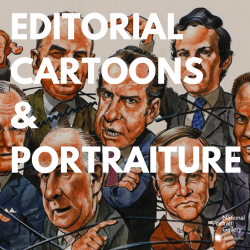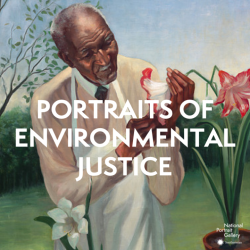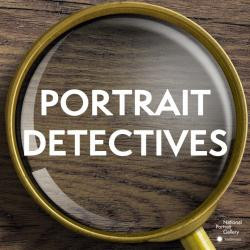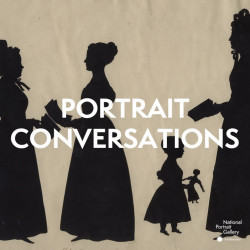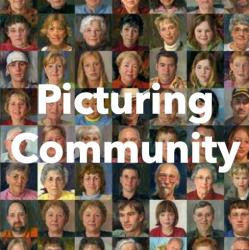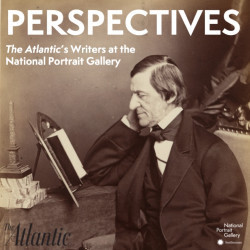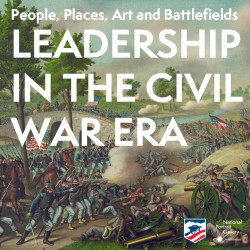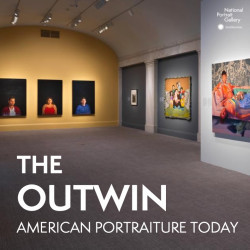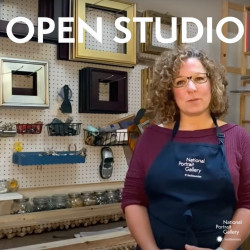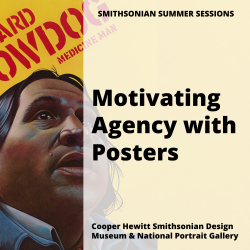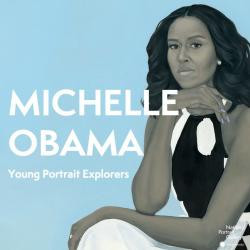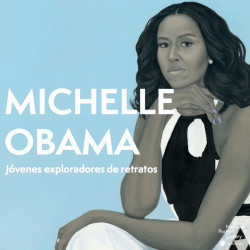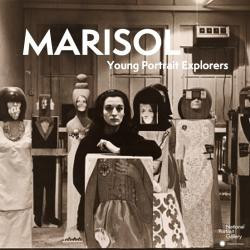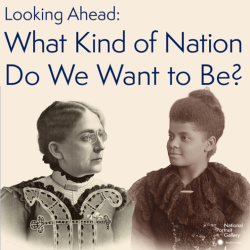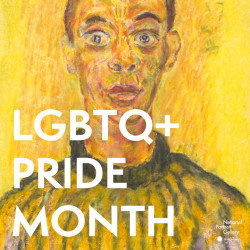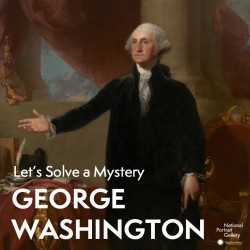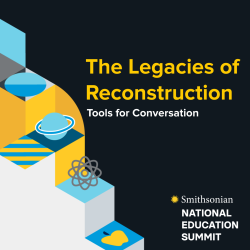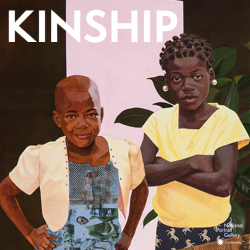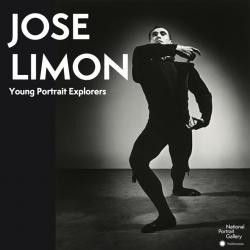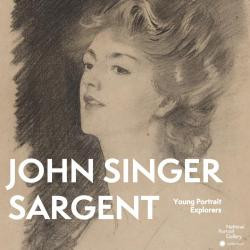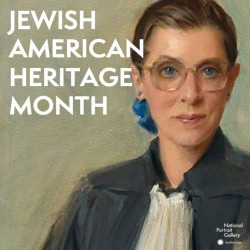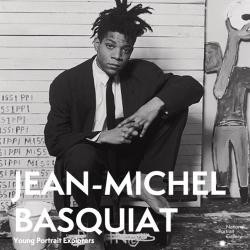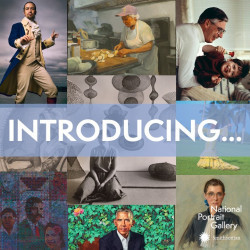Nicole Vance's collections
PORTRAITS Podcast: Editorial Cartoons and Portraiture
<p>In this lesson, students will explore editorial cartoons as portraits and how the satirical art of cartoonists is reflective of their perspectives and time in American history. By comparing two National Portrait Gallery collection portraits, (<a href="https://npg.si.edu/object/npg_NPG.72.2" target="_blank" rel="noreferrer noopener"><em>Richard Nixon</em></a> by Norman Rockwell, <a href="https://npg.si.edu/object/npg_NPG.78.TC178?destination=edan-search/default_search%3Fedan_local%3D1%26edan_q%3Dwatergate%252Bbreaks%252Bwide%252Bopen" target="_blank" rel="noreferrer noopener"><em>Watergate Breaks Wide Open</em></a> by Jack Davis) students will discover similarities and differences in how political figures are portrayed. Students will also have the opportunity to listen to the perspectives of art historians and contemporary editorial cartoonists and explore the applications of satirical art past and present. </p>
<p>This lesson plan was written by NPG Teacher Advisory Board Member Christoper Evans ALM, M.ED, who works as a Social Studies Teacher at Basha High School in Chandler, AZ.<br></p>
<p></p>
 Nicole Vance
Nicole Vance
29
Portraits of Environmental Justice
<p>What is our relationship to the rest of the natural world, and what are our responsibilities toward it? How do scientific, political, social, economic, aesthetic, and moral considerations factor into our decisions? In this collection learn about key people—scientists, politicians, activists, writers, and artists—whose work has influenced attitudes toward the environment in the United States.</p>
<p>This collection includes portraits from <a href="https://npg.si.edu/exhibition/forces-nature-voices-shaped-environmentalism-0"></a><em><a href="https://npg.si.edu/exhibition/forces-nature-voices-shaped-environmentalism-0">Forces of Nature: Voices that Shaped Environmentalism</a></em> on view at the National Portrait Gallery October 20, 2023 - September 2, 2024.</p>
 Nicole Vance
Nicole Vance
97
Portrait Detectives
<p>This Learning Lab complements the National Portrait Gallery's student program, Portrait Detectives.</p>
<p>Students will be transformed into Portrait Detectives, searching portraits for and analyzing clues to learn more about significant Americans. Through interactive discussions and sketching and writing activities, students will read, compare, and contrast portraits across the collection. This module is divided into the following themes to best support your curriculum and student interests: Presidents, Activists, Icons, and Scientists.</p>
<p><strong>Objectives:</strong></p>
<p><strong></strong>After completing this lesson, students will be better able to: </p>
<ul>
<li>Identify important Americans and analyze their contributions to U.S. History <br>
</li>
<li>Identify key components of a portrait and discuss what we can learn about the sitter through these components.</li></ul>
<p><a href="https://npg.si.edu/teachers/school-groups">Schedule</a> a virtual Portrait Detectives program with National Portrait Gallery educators.</p>
<p>#NPGteach</p>
<p><br></p>
 Nicole Vance
Nicole Vance
90
People, Places, Art and Battlefields: Leadership in the Civil War Era
<p>This Learning Lab complements "People, Places, Art and Battlefields in the Classroom: Leadership in the Civil War Era" a teacher workshop cohosted by the National Portrait Gallery, the <a href="https://www.battlefields.org/" target="_blank">American Battlefield Trust</a> , and veteran educators. </p>
<p>This collection highlights the intersections between art and battlefields, during the Civil War and encourages connections and discussions between people and places.<br></p>
<p>After completing this lesson students will be able to:</p>
<ul><li dir="ltr"><p dir="ltr">Identify what leadership during the Civil War looked like;</p></li><li dir="ltr"><p dir="ltr">Connect the battle of Antietam and individuals who played a significant role in the diverse stories of the battlefield;</p></li><li dir="ltr"><p dir="ltr">Identify resources from both the American Battlefield Trust and the National Portrait Gallery.</p></li></ul>
<p>Keywords: people, places, battlegrounds, battlefields, Antietam, Civil War, Union, Confederacy, monuments, Frederick Douglass, Abraham Lincoln, Robert E. Lee, William Seward, George B. McClellan, Clara Barton, William McKinley, Robert Gould Shaw<br><br></p>
<p>#NPGteach<br></p>
<p><br></p>
<p><br></p>
 Nicole Vance
Nicole Vance
91
Outwin 2019: American Portraiture Today
<p>Explore portraits from <em>The Outwin 2019: American Portraiture Today </em>at the National Portrait Gallery in this Learning Lab collection.</p>
<p><em>The Outwin 2019: American Portraiture Today</em> presents nearly 50 portraits that were selected through an open call that garnered more than 2,600 entries from artists working across the United States and Puerto Rico. For the first time in the triennial’s history, the museum specifically asked that submissions respond “to the current political and social context,” and this resulting presentation offers perspectives on some of today’s most pressing issues.</p>
<p>The selected finalists create portraits in a wide range of media—painting, drawing, photography, sculpture, time-based media art, installation, and performance—but all are keenly aware of portraiture’s potential to insist on the presence, and importance, of every human being. 2019's Outwin aims to advance the art of portraiture for future generations while encouraging visitors to empathize and locate meaningful connections.</p>
<p>Every three years, the National Portrait Gallery invites both emerging and established artists working in the U.S. to submit a recent portrait to the Outwin Boochever Portrait Competition. Around fifty works are then selected by expert jurors who, on average, review more than 2,500 entries. The competition has evolved since its inception in 2006 to include performance art and time-based media alongside painting, photography, drawing, and sculpture.</p>
<p>As part of its deep commitment to supporting contemporary artists working in portraiture, the National Portrait Gallery looks to the Outwin to share the genre’s remarkable relevance and strengthen the visual representation of American history. Each iteration of the competition gauges portraiture’s progression while underscoring the potential of one person to make an impact.</p>
<p>The Outwin is made possible through the Virginia Outwin Boochever Portrait Competition Endowment, established by Virginia Outwin Boochever (1920–2005), who served as a docent for the National Portrait Gallery for nearly two decades. Mrs. Boochever’s vision for the Outwin is now carried out by her children.</p>
<p>Educators, to explore these portraits with your students through close looking and visible thinking routines, see the resources at the end of this collection for ideas.</p>
<p>#NPGteach</p>
 Nicole Vance
Nicole Vance
68
Our Struggle for Justice: A Digital Collaboration between the National Portrait Gallery & Capital One
<p><em>What can you do to make a difference?</em> Introducing <a href="https://npg.si.edu/visit-home/digital-engagement">Our Struggle for Justice</a>, a digital collaboration between the <a href="https://npg.si.edu/">National Portrait Gallery</a> and <a href="https://www.capitalone.com/">Capital One</a> that explores activism and social justice through biography.<br><br></p>
<p>How can you use your skills to spark conversation, create agency and inspire change? In this collection, meet individuals, past and present, from the museum’s collection whose thoughts and actions have made our nation better. Each featured individual is accompanied by thought-provoking questions, educational resources, and additional portraits to reframe the way we view activism and the causes closest to us.<br></p>
<p>Join us on <a href="https://www.instagram.com/smithsoniannpg/">Instagram</a> and <a href="https://twitter.com/smithsoniannpg">Twitter</a>, follow #OurStruggleForJustice for the latest updates, and look out for new posts each Tuesday. </p>
<hr>
<p>Through our Twitter and Instagram, we will delve into the museum’s collection to contextualize the pursuit of freedom and activism in the United States, sparking conversation and inspiring action. </p>
<p>Our country was established on two basic principles: freedom and the pursuit of happiness. However, over the course of our history, these ideals have been broken, tested and reconstructed. Many times, the onus for upholding the nation’s moral foundation has fallen to the individual rather than the majority. </p>
<p>American activism guides our nation toward its true vision, one that acts upon the ideals of its founding and celebrates the entirety of its population. And while many before us defined what it means to strive for a better America, there is no question that this work is ongoing. </p>
<p>Through Our Struggle for Justice, we will meet individuals, past and present, whose thoughts and actions have made our nation better. Though their experiences and causes vary, these people have one thing in common: they fought tirelessly against injustice, using their time, strengths and sheer will to create meaningful change. </p>
<p>In telling these stories, we aim to spark conversations around agency. Look for thought-provoking questions to reframe the way we think about activism and the causes that are closest to us. <br></p>
<p>The campaign draws inspiration from the Portrait Gallery’s collection, including the permanent exhibition The Struggle for Justice, which celebrates pioneers and change-makers in the fight for social equity. </p>
<p>One person can make a difference. In learning about these figures, we hope that you can, too. <br></p>
 Nicole Vance
Nicole Vance
112
Michelle Obama: Jóvenes exploradores de retratos
<p>Aprender sobre cómo la primera dama Michelle Obama ayudó a su comunidad (grupo de personas que viven juntas o comparten algo en común). Y luego diseñar un autorretrato en el que muestres cómo tú ayudas a tu comunidad<br></p>
<p>#NPGteach </p>
<p>La traducción de este recurso fue posible gracias al generoso patrocinio de Bank of America.</p>
 Nicole Vance
Nicole Vance
29
Marisol Escobar: Young Portrait Explorers
<p>Discover how fun and funky portraiture can be through the artwork of Marisol Escobar, also known as Marisol.</p>
<p>#NPGteach</p>
<p>Keywords: Marisol Escobar, Assemblage, Sculpture, Found Objects, Pop Art, New Realism, Portraiture, Venezuelan-American, Latinx Artists, Women Artists, </p>
 Nicole Vance
Nicole Vance
30
Looking Ahead: What Kind of Nation Do We Want to Be?
<p>How can the past inform our future? Imagine you are living in the U.S. in 1899. In this era of rapid expansion and increasing tensions many Americans are asking "what kind of nation do we want to be?" Across the United States, people are talking about what that means for themselves and for their country. For this lesson, students will imagine they are gathered in an issue forum. This guide is meant to provide a framework for student deliberation by offering three approaches to the complex question: "what kind of nation do we want to be?" Each option is accompanied by possible actions to be taken and notes possible drawbacks.</p>
<p>#NPGteach</p>
 Nicole Vance
Nicole Vance
18
Kinship
<p>Explore portraits from "Kinship" at the Smithsonian's National Portrait Gallery in this Learning Lab collection.</p>
<p>"Kinship" features the work of eight contemporary artists who illuminate the complexities of our closest interpersonal relationships through portraiture. Njideka Akunyili Crosby, Ruth Leonela Buentello, Jess T. Dugan, LaToya Ruby Frazier, Jessica Todd Harper, Thomas Holton, Sedrick Huckaby, and Anna Tsouhlarakis poignantly visualize the nuances of this theme within and outside of family units. Through painting, photography, sculpture, and performance, the artists reveal how kinship, by its very nature, embraces contradictions. They also highlight the crucial role that storytelling and memories have in connecting different generations, encompassing both the living and the dead.</p>
<p>When we started working on this project in 2018, there was no way we could have predicted that its core concepts were about to be tested on a global scale. The separation and overwhelming loss resulting from the COVID-19 pandemic, the renewed calls for social and environmental justice, and recent armed conflicts have deepened the resonance of the exhibition’s themes. Vulnerability, intimacy, privacy, community, familiarity, and recognition have all been questioned and realigned, underscoring how portraiture provides a shared space for empathy and understanding.</p>
<p>Kinship <em>is the latest in the museum’s </em>Portraiture Now<em> series, which was established in 2006 to highlight contemporary artists whose work focuses on portraiture or figurative art.</em></p>
<p><em>...<br></em></p>
<p><em>Parentescos presenta a ocho artistas contemporáneos que abordan a través del retrato las complejidades de nuestras relaciones interpersonales más estrechas. Njideka Akunyili Crosby, Ruth Leonela Buentello, Jess T. Dugan, LaToya Ruby Frazier, Jessica Todd Harper, Thomas Holton, Sedrick Huckaby y Anna Tsouhlarakis visualizan con emotividad los matices de este tema dentro y fuera de las unidades familiares. En pintura, fotografía, escultura o performance, los artistas revelan que el sentido de parentesco —sea por afecto, afinidad o sangre— acoge contradicciones por su propia naturaleza. Asimismo destacan el rol crucial de los relatos y recuerdos en cuanto conectan a las generaciones, a los vivos y los muertos.<br><br>Al iniciar este proyecto en 2018, no anticipamos que sus conceptos medulares pronto serían puestos a prueba a escala global. La separación y la abrumadora pérdida causadas por la pandemia de COVID-19, el renovado reclamo de justicia social y ambiental y los recientes conflictos armados han exaltado la resonancia de los temas de esta exposición. Las nociones de vulnerabilidad, intimidad, privacidad, comunidad, familiaridad y reconocimiento han sido todas cuestionadas y reajustadas, poniendo de relieve el retrato como espacio compartido de empatía y comprensión.<br></em></p>
<p><em><br></em></p>
 Nicole Vance
Nicole Vance
51
José Limón: Young Portrait Explorers
<p>Learn about José Limón’s love for dancing and how he created his own dance technique (a certain way of doing something). </p>
<p>#NPGteach</p>
<p><strong>Keywords:</strong> José Limón, dance, choreography, movement, rhythm, expression, chaconne</p>
 Nicole Vance
Nicole Vance
25
John Singer Sargent: Young Portrait Explorers
<p>Discover the artwork of John Singer Sargent (1856–1925) and learn about some of the techniques he used for drawing portraits.</p>
<p>#NPGteach</p>
<p><strong>Keywords:</strong> John Singer Sargent, Shading, Charcoal, Shades, Highlighting, Strokes, Portraits, Drawing</p>
 Nicole Vance
Nicole Vance
33

